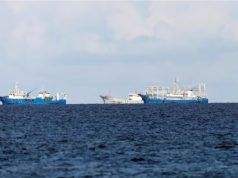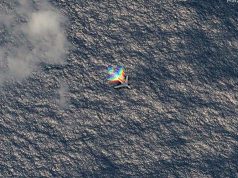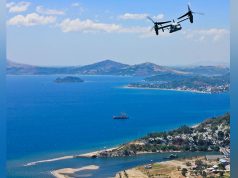
MANILA, Philippines – This is the right time for the Philippines to push for the implementation of the ruling of the UN Arbitral Tribunal on the West Philippine Sea (South China Sea) while the country chairs the Association of Southeast Asian Nations (Asean).
This is the position of former Philippine Department of Foreign Affairs (DFA) Secretary Albert del Rosario in relation to the country’s long-standing territorial dispute with China.
He also urged other Asean members to unite and persuade China to follow international laws in relation to the West Philippine Sea issue and include in this year’s Asean summit agenda discussions about the Spratlys as many of the territory’s claimants are also members of the association.
“The purpose of our cooperation should go beyond maintaining friendly ties; we must also cooperate to ensure that we live in a neighborhood where countries follow the rules and uphold their commitments,” Del Rosario said on Wednesday, April 26, as Asean marks its 50th anniversary under the chairmanship of the Philippines.
The former DFA chief worries that the Philippines might lose its influence in the region if President Rodrigo Duterte won’t be able to push the Spratlys issue as among the agenda during the summit.
Del Rosario said it would be easy for Duterte to include the issue in the agenda because the ASEAN chairman is the one who sets the summit’s theme.
Analysts weigh in
Meanwhile, experts agreed that the Philippines should take the opportunity to raise China’s expansion during this week’s summit.
Prof. Richard Heydarian, foreign policy analyst, said, “I’m not impressed with how the Duterte administration does its work. There’s still sufficient time for the Duterte administration to take advantage” of Manila’s being ASEAN chair this year.
Another analyst said ASEAN should at least urge claimant countries to follow the rule of law, in particular, the UN Convention on the Law of the Sea where both the Philippines and China are among the signatories.
Dr. Jay Batongbacal, director of the UP Institute for Maritime Affairs and Law of the Sea, said,”I’m not really concerned with the ASEAN statement; any reference to the rule of law and implementation of UNCLOS is already enough.”
Del Rosario, who led the Philippines’ filing of the arbitration case against China in 2013, called Beijing’s moves to reclaim and build structures in the South China Sea “unlawful.”
China’s “unilateralism,” he claimed, threatens ASEAN’s efforts to promote a “peaceful… rules-based regional order”.
Ruling in The Hague
The Philippines won its case against China after the UN Arbitral Tribunal ruled in July 2016 that the country had exclusive sovereign rights over the West Philippine Sea and that China’s nine-dash line was invalid.
The nine-dash-line serves as basis of China’s supposed historical rights in the region incuding the Spratlys that encircles as much as 90 percent of contested waters that runs as far as 2,000 kilometers from the Chinese mainland to a few hundred kilometers of the Philippines, Malaysia, and Vietnam.
The same ruling said Beijing “had no historic rights to resources in the waters of the South China Sea” and that “such rights were extinguished to the extent they were incompatible with the exclusive economic zones provided for in the” UN Convention of the Law of the Sea.
The Spratly Group of Islands is among the major archipelagos within the West Philippine Sea (South China Sea) that has rich fishing grounds and is believed to be rich in oil and natural gas reserves. It consists of 14 islands, islets and cays, and over 100 reefs.
Besides the Philippines, Asean members Brunei, Malaysia, and Vietnam are also claiming portions of the Spratlys. The other non-Asean claimant is Taiwan, which occupies Itu Aba, the biggest island in the Spratlys.
Brunei has included Louisa Reef within the Spratlys in its exclusive economic zone.
Malaysia has occupied three islands within the Spratlys that it considers to be within its continental shelf. These are Ardasier Reef (Terumbu Ubi); Mariveles Reef (Terumbu Mantanani); and Swallow Reef (Terumbu Layang).
Vietnam claims the entire Spratly Islands as an offshore district of the province of Khanh Hoa. It controls 21 islands, reefs, shoals, and cays.
These are: Alison Reef; Amboyan Reef; Barque Canada Reef; Central London Reef; Cornwallis South Reef;Da Gri-san; Da Hi Gen; East London Reef; Great Discovery Reef; Ladd Reef; Landsdowne Reef; Namyit Island; Pearson Reef; Petley Reef; Sand Cay; Sin Cowe Island; South Reef; South West Cay; Spratly Island; Tennent Reef; and West London Reef.
The Philippines is claiming 52 features within the Spratlys but was only able to occupy within the Kalayaan Island Group seven islands, two reefs, and one cay.
These are Pag-asa Island or Thitu Island; Likas or West York Island; Parola or North East Cay; Lawak or Nanshan Island; Kota or Loaita Island; Patag of Flat Island; Panata or Lamkian Cay; Rizal or Commodore Reef; Balagtas or Irving Reef; and Ayungin or Second Thomas reef.









